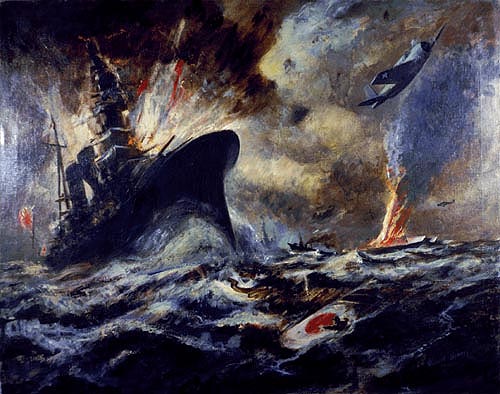
U.S. Navy
Seventy years ago this month, the battles of Coral Sea and Midway set the United States firmly on course to become the world’s undisputed naval power. How long it will remain so and whether it matters are questions central to any debate about U.S. military spending. These questions should not be answered lightly. Few lessons from history have remained as incontestable as the importance of sea power to a nation’s political and economic standing.
Sea power has been the ultimate measure of global reach and influence since the Greeks stemmed Persia’s land conquests with a naval victory at Salamis Bay in 480 B.C. Despite having the largest and best-trained army in Europe in the mid-1700s, France lost its overseas empire, including Canada, to Great Britain because France could not support its colonies via the seas. Great Britain held onto a worldwide empire where the “sun never set” throughout the nineteenth century only because of the superiority of the Royal Navy.
By 1898, the United States was flexing its muscles on two oceans. New innovations in iron and steel battleships produced an arms race in dreadnoughts that were capable of ever-increasing speed, range, and firepower. Great Britain fought to maintain its dominance, while Germany, in particular, challenged its naval strength. Ironically, during World War I, Germany poured huge resources into creating a powerful fleet but then used it tentatively before sequestering it in safe ports for the duration. But recognizing how close Germany had come to mastering the seas, Great Britain and its allies, including the United States, made certain that Germany’s fleet was confiscated at the war’s end.
After this war to end all wars, idealists from the major powers convened in Washington, D.C. in November 1921 for the Washington Naval Conference. The results were limits on naval tonnage and capital ship construction. If navies were kept small, the argument ran, there could be no great clash of arms. Japan, a nominal member of the World War I victors, was only too glad to accept levels below those of Great Britain and the United States, because while these latter countries respected the limits for the better part of fifteen years, Japan ignored them and surged toward parity in naval might.
Only Franklin D. Roosevelt’s slow buildup of the American navy during the late 1930s kept Japan from surpassing American naval strength. As devastating as the surprise attack on Pearl Harbor was, the American navy had already begun to embrace aircraft carriers and naval aviation—instead of battleships—as the new weapons of naval superiority. Japan’s attacks throughout the Pacific in December 1941 were evidence of the effectiveness of these weapons, but the Americans would soon prove it in spades.
In May 1942, just five months after Pearl Harbor, Allied naval forces led by the American carriers Lexington and Yorktown engaged in the first sea battle fought exclusively between aircraft and blunted the Japanese advance at the battle of Coral Sea. The action protected the critical West Coast-to-Australia lifelines and arguably saved Australia from invasion. Less than a month later, American pilots from three carriers near Midway sank four Japanese carriers that Japanese shipyards could not readily replace. The United States on the other hand not only replaced the Lexington, sunk at Coral Sea, and Yorktown’s loss at Midway, but also launched twenty-one other fast carriers over the next three years.
By the time Fleet Admiral Chester W. Nimitz signed the Japanese surrender for the United States aboard the battleship Missouri in Tokyo Bay in 1945, the United States was the undisputed naval power in the world. Its opponents had been crushed and its allies weakened by the demands of victory. Only the United States had been able to flex its industrial muscle and float new ship construction that net of battle losses included the fast carriers, 70 escort carriers, 35 cruisers, 206 destroyers, 361 destroyer escorts, and 120 submarines—most built during a three-year period. Today, the entire American fleet has only 286 ships, about half the number of the Reagan Administration’s build-up of the late 1980s.
After World War II, land-based air power became both an essential cold war capability and a deterrent. Yet it has consistently been sea power, frequently delivered by aircraft carriers, that has maintained America’s political and economic leadership. The United States Navy has quarantined Cuba during the missile crisis, kept the Strait of Hormuz and other vital waterways open, and dispatched American aid around the globe in response to military crises and for humanitarian efforts.
How long American naval superiority will last is uncertain, but as to whether or not it matters, history shows the answer to be a resounding “yes.” China holds approximately $1.2 trillion of United States debt. In a global economy of friendly competition, many view this a matter of course. But what if China used twelve billion dollars of this debt—1% —to deploy an aircraft carrier operating off each coast of the United States? The dynamics suddenly change. Whether the threat comes from another country or from machine-gun-toting pirates or suicide terrorists, an international economy requires naval power.
Those who say that threats have diminished do not understand history. With 70% of the globe covered by water, the country that wields naval power most effectively has always maintained a position of political and economic leadership. The dominance of the United States Navy must be maintained if America is serious about continuing its role as a global leader in the twenty-first century. There is no substitute for sea power and history has proven that if the United States doesn’t do exercise it, some other nation will.
Walter R. Borneman is the author of The Admirals: Nimitz, Halsey, Leahy, and King—The Five-Star Admirals Who Won the War at Sea, just published by Little, Brown.


